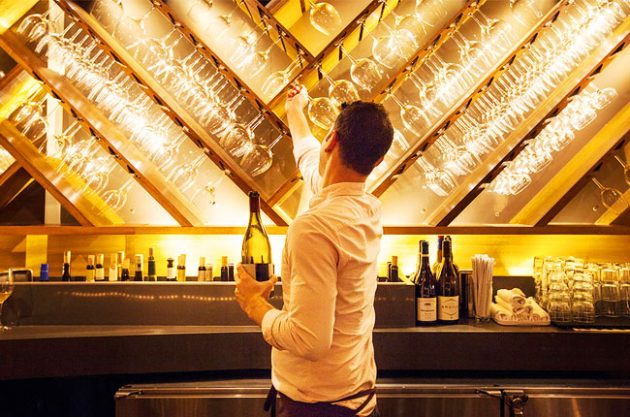A nonconformist guide to making wine…

Jefford: Guerrilla guide to drinking wine – Part four
Andrew Jefford explores 10 rules around drinking wine in the final chapter of his four-part August series … for absolute beginners.
Guerrilla (noun) = member of a small independent group taking part in irregular fighting, typically against larger regular forces
Guerrilla (adjective) = referring to actions or activities performed in an impromptu way, often without authorisation
Part four: Drinking wine
1: You have impeccable tastes
For you. If you’ve given a wine time and attention, drunk it both with food and without, ideally over a day or two, then your guerrilla verdict on that wine is irrefutable. Advance from there – by finding similar things if you liked the wine, or by steering clear of similar things if you didn’t. The verdicts of others may be interesting (and everything is worth trying once), but others don’t have your nose, your papillae or your cranial jelly, wobbling with your own sensual memories and desires. Wine gets inside you, remember. Respect that intimacy; respect your own judgment.
2: Those tastes will change

Tasting wine at a Decanter ‘discovery theatre’ class on Muscat de Rivesaltes. Credit: Decanter / Soora.co.uk
Slowly. Most of us abandon the merely simple wines, which lack resonance and are repetitive; most of us see through the pretentious wines, and tire of those whose charms prove specious; most of us gradually come to understand the difficult ones, disentangle their discourse, see the beauty in their challenges, their affronts and their singularities. Maybe we give up being guerrillas at that point, and hand over our weapons. Maybe we start to do a little preaching ourselves, to friends and colleagues-in-arms. No need to hurry, though. Enjoy the journey from one set of wines to another, from one moment in life to another.
3: Cheap wine is dull
Well … if you’ve been in the jungle for six months and it’s the first glass you taste afterwards, maybe not. Any wine is better than no wine. But there’s a sad logic to discounting. Perhaps no one wanted to buy that wine at a better price; perhaps it’s industrial wine made by industrial farming in an uninteresting place. It might, of course, be made from an obscure grape variety in an unfashionable place by under-rewarded workers, or bought exploitatively by a supermarket abusing its purchasing power. If it was truly good, though, it wouldn’t be trapped in that way: this is a responsive market. (And purchase, guerrillas recall, is always a political act.)
4: Expensive wine is over-priced
And it gets more expensive (and thus more over-priced) every year. Why? Each increment in quality is shared by ever-fewer wines. Every year, though, adds to the global stock of wealthy individuals who covet those wines – so slight increments in quality are disproportionately rewarded. Questions of value, though, only have meaning in relation to personal wealth. If you’re a rich guerrilla, give all the expensive wines a try. If you’re not, there’s plenty of wine action elsewhere.
5: Value lies in the middle
Like here. Once you get beyond paying the minimum, you start to reward the winegrower more than the intermediaries who put the wine in your hands (and the governments who see fit to tax your pleasure). You start to pay for the quality of the place, for a lower crop, for gentle handling, for the raised ambitions of a new generation. The wine world is an organism in constant mutation; reputations take generations to build. It’s during this process that you find under-valued wines – so pay a bit more, but be demanding with the extra. The wine world is so diverse, and production in so many hands, that you could spend a contented lifetime doing this (though most of us settle down with a few old friends by the end).
6: Descriptions, descriptions
What to try? Guerrillas sometimes have to operate autonomously; you may need a priestly suggestion or two. There’s now an entire industry to serve you, grinding out tasting notes and scores in their thousands every week and shovelling them out of web servers over the wine jungle: propaganda by subscription. The process can seem robotic and the tasting descriptions interchangeable and predictable, veering off occasionally into incomprehensible, but the service is nonetheless useful and it’s easy to gauge enthusiasm from scores. If you can find the wine in question (certainly the biggest challenge), you can then score the scorer based on your own tastes – a useful act. (Alternatively, get to know a good merchant who sells without lying.)
7: Don’t stress about alcohol
There’s a new dogma in the temple – that all wine should aspire to the divine condition of being just 12.5%. This is like saying that all animals should aspire to the condition of being horses. Folly: you can’t blow up dogs, shrink elephants or stick legs on seals. Great wine is made from fully ripened fruit from well-adapted varieties in distinguished sites, none of which are identical – so for many red wines and some whites, that means a naturally articulated, unstrenuous 14.5% or 15%. Such wines can still be balanced and fresh. Wines made from underripe fruit, by contrast, tend to be taut, hard, mean, awkward and inarticulate: muzzled, blindfolded and straitjacketed into something they were never meant to be. Always decide if you like a wine or not by slow engagement, without looking at the alcohol level.
8: Out to eat

Kwint restaurant in Brussels. Talk to the sommelier and know your price limits. Image Credit: Sergi Reboredo / Alamy Stock Photo.
Even guerrillas find themselves in restaurants sometimes. Step one: rate the wine list (if it’s bad, stick to beer). Step two: find a wine you know — to see by how much it’s been marked up. Fix your price ceiling. Step three: if there’s a sommelier, chat to him or her and see if they sound convincing and if you’d therefore be prepared to try their imaginative, interesting, crazy, stupid, trendy, predictable or alarmingly expensive suggestion (it’s not obligatory). Step four: if you spot a wine you know you like on the list, ask yourself if there is any compelling reason not to choose it. Step five: chat your provisional choice through with your guests to pre-empt criticism, cross your fingers – and jump.
9: The old stuff isn’t best
The wine world has its myths, and many of them concern old bottles. What is it people enjoy when they try old wine? Is it the liquid – or the dusty glass, the distressed label, age itself, vintage memories, the act of endurance, a reputational aura, collector kudos? It may be that the wine is mellowly exquisite – but more often it’s just old (uneventful, thin, lined, gaunt, bony, acidic or oxidised) and it would have been better when it was younger. To point this out often seems disrespectful or insulting both to the old bottle and the person who had looked after it for all these years and is now sharing it with you, so we all sing along with the hallelujah chorus; thus the myth is sustained. Remember that it’s ‘mature’ you’re after, not old – and maturity (for this wine and your palate) may come at six months, a year, two years …
10: And after

Technology means that you don’t have to commit everything to memory…
Now it’s up to you. There are entire mountain ranges of nomenclature ahead, but in the search-engine age you don’t have to commit them all to memory. It’s the tasting journey which is most interesting, and pooling resources with fellow guerrillas can get you further faster. Nothing’s obligatory, though. The key encounter is between you, a bottle, a glass, some food … and a moment of respite. The food satisfies, but it’s often the wine which possesses the more complex flavour: an intoxicating message from somewhere else on our planet, crafted by a stranger you don’t know but who, like you, is fascinated by this sensual manner of apprehending earth, sky and seasons through the fermented juice of grapes. We draw sustenance from this – physical, psychological, perhaps even spiritual; and go on.
A fully revised and updated edition of Andrew Jefford’s Wine Course is now available in English (Ryland, Peters & Small) and in French (as Le Grand Livre du Vin, Eyrolles)
Read Andrew Jefford’s first three guerrilla guides to wine:
